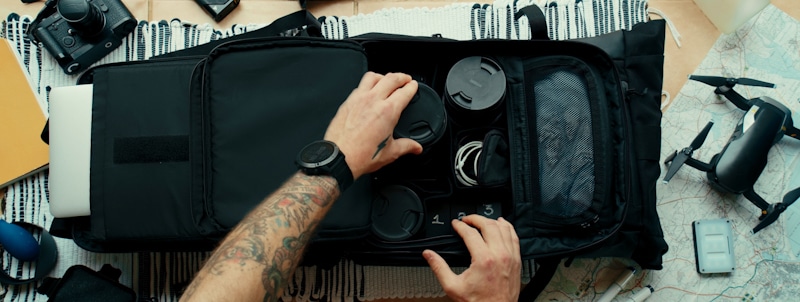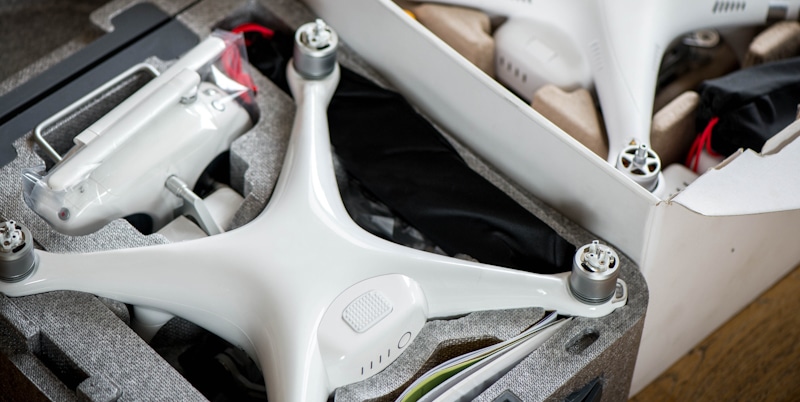Drones are so much fun you may want to take one with you the next time you go on vacation. However, it's important to make sure that you follow all the rules when you're using your drone. So, can you take a drone on a plane in your carry-on luggage?
Drones and other unmanned aircraft are considered restricted items so you can't legally carry them in the luggage you take onto a plane with you. However, since batteries can explode under the right conditions these must be packed in your carry-on luggage and carried onto the plane with you.
Carrying Batteries in Your Carry-on Bag
Whenever you take a trip by plane you'll need to check your drone. However, your batteries will need to be with you in a carry-on bag. This is because you should never store batteries in a pressurized environment or they will rupture. Carrying your batteries on board with you will also ensure that they aren't exposed to fluctuating temperatures which could cause your battery to die. Additionally, by storing your drone's batteries in an overhead compartment you're ensuring that airline staff can quickly respond in the event that an emergency does occur.

Additional Tips for Carrying Batteries On-Board
When you're bringing LIPO batteries with up to 100 Wh (watt-hours) in your carry-on baggage with you these are the tips you should follow:
- To prevent the batteries from short-circuiting they can't be left loose in your bag. You'll need to pack them in one of the following ways:
- In their original packaging
- In a battery case
- In a plastic bag or protective pouch (e.g. LIPO-safe bags, DJI camera backpack)
- In a battery sleeve tucked inside of a camera bag
- With their terminals covered in tape
- You can't bring batteries for resale or distribution, only for personal or professional use
- You can only bring three batteries with you (you can only bring two if they're over 100 Wh) plus the battery in your remote and additional camera or AA batteries
- You'll need to get special approval from the airline if you want to bring a larger LIPO battery (over 100 Wh) on board with you (All but the DJI Inspire 1 should be fine)
Make sure you check with the airline to see if they have any additional requirements regarding carrying LIPO batteries on board.
Staying Below Your Airline’s Watt-Hour Limit
The number of batteries you'll be allowed to carry onboard will depend on their watt-hours. The FAA (Federal Aviation Administration) says on their website that you can bring as many batteries as you want as long as they're below 100 Wh. However, if your batteries are 101 – 160 Wh you'll only be allowed to bring two with you.
While most drones' batteries are well below 100 Wh (e.g. Inspire 2 is at 97.58 Wh; Mavic is at 43.6 Wh) there are some high capacity batteries that you need to be careful with (e.g. Inspire 1 is 101 – 160 Wh). The high-capacity batteries are the ones you'll need to only bring two batteries on board. However, you should know that these regulations don't apply to every airline or even every country so you'll want to check with the aviation administration regulations in the country that you'll be traveling in.
Understanding Watt-Hours
Most drones are powered by lithium batteries (a.k.a. LiPo). The FAA has established guidelines around their Wh in regards to what you're allowed to bring on board with you. It's important to understand that these regulations do vary depending on the country you're traveling in which is why you should check their guidelines before your trip.
How to Determine Your Drone’s Batteries’ Watt Hours
To determine how many watt-hours your battery has you'll need to convert amp-hours (Ah) to watt-hours. For this, you simply multiply Ah by voltage (Wh = V x Ah). For instance, if you have a 12-volt battery with 8 Amp-hours it'll have 96 watt-hours (12 x 8 = 96).
You'll find that most of the drones that are manufactured by DJI will be under 100 Wh so you won't need to advise the airline that you'll be bringing them with you. However, it's still important to make sure that you pack your batteries properly.
Choosing the Right Bag or Case for Carrying Your Drone
There are a lot of bags and cases that are specifically made for carrying your drone. You should opt for one that has a hard shell case on it since you'll be checking your drone and want to make sure it arrives safely.
There are also a variety of bags that have been specifically designed for carrying LiPo batteries. These aren't only useful because the airline mandates their use but also because they'll help mitigate damage in regards to combustion. Thus the likelihood of anything catching on fire is reduced.
Taking Your Drone Through Customs
Drone regulations are usually set and enforced by a country's national or civilian aviation authority. For instance, in the United States, they're set by the FAA. This is why you should know who the civil aviation authority is in the country you're traveling to. It'll help you learn more about their drone laws.
Countries Where It’s Legal to Fly Drones
When you're flying in a country where drones are legal you should make sure to look for any drone laws that have been drafted especially for foreigners. You may need to obtain special permission to fly your drone or you may need to register it with the country's national or civil aviation authority. Make sure you follow the country's requirements.

Countries Where It’s Illegal to Fly Drones
There are some countries that have completely banned the use of drones because they feel they're a security risk. If you arrive in one with a drone you may be denied entry to the country or you may have your drone confiscated. These countries include Algeria, Barbados, Cuba, Iran, Iraq, Kuwait, Madagascar, Morocco, Nicaragua, and Syria.
There are also other countries where you must register your drone before you're allowed to fly it. These countries include Asia, Africa, the Bahamas, many countries throughout Europe, and also the United Kingdom. If you don't take your time to register your drone for recreational flight in these countries you could not only have your drone confiscated but also find yourself faced with some stiff fines.
When you decide that you want to travel to a country that has completely banned drone flight you shouldn't even attempt to bring your drone with you. Doing so may result in your drone and all of its gear being confiscated at customs. You may or may not be able to pick your drone up again when you're leaving the country on your return flight home. This probably isn't a risk that you're willing to take considering how expensive a lot of this gear can be. So save yourself the time, money, and hassle: Leave your drone at home when traveling there.
Popular Airlines and Their Rules
It's important to remember that the rules do vary somewhat depending on which airline you'll be traveling with. Here are some of the most popular airlines and their regulations regarding drones.
Air Canada
With Air Canada, you'll need to remove all batteries before checking your drone in for the flight. You should carry your LiPo batteries on board with you in proper packaging.
American Airlines
It's important that your drone's battery doesn't exceed 160 Wh. You must remove these batteries from your drone and place them in LiPos bags. You're allowed an unlimited number of batteries with up to 100 Wh but if your batteries are 100 – 160 Wh you'll only be allowed to carry two with you.
British Airways
Drones aren't specifically mentioned on British Airways' website. However, they do mention "Batteries, Electric, and Electronic Devices." In this section, they say that you're allowed to carry up to four batteries (up to 100 Wh each) with you either in their original packaging or in LiPo bags. To carry batteries of 100 Wh – 160 Wh you'll need to get their approval first.

Delta
Delta also doesn't specifically address drones but they do have a section regarding "Personal Electronic Devices." These are to be carried in your hand luggage and not put in the checked baggage. They'll let you carry up to 20 LiPo batteries with up to 100 Wh and two, 100 – 160 Wh LiPo batteries. Each of these batteries needs to be placed in its own separate LiPo bag.
Conclusion
The next time you want to take your drone with you on vacation make sure you pay attention to the rules regarding taking them on an airplane with you. While you can't legally carry your drone onto an airplane with you, it's possible to put them in the luggage that you check-in when you arrive at the airport. Make sure you don't pack your batteries there though. Since batteries can easily explode under the right conditions, those do need to be carried with you in your carry-on luggage.
Shawn Manaher loves to play with new toys and dive into new hobbies. As a serial entrepreneur, work definitely comes first but there is always room for hobbies.

